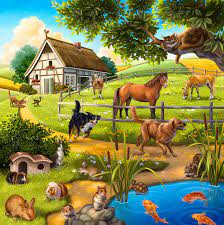From the ancient cave paintings of Lascaux to the contemporary masterpieces of wildlife photography, the depiction of animals in art has been a timeless and captivating subject. While artists throughout history have approached this theme in various ways, one particular avenue of exploration that has sparked both fascination and controversy is the genre known as “zoo art.”
Zoo art, as the name suggests, encompasses artistic representations of animals found in zoos. These representations can take many forms, including paintings, sculptures, photographs, and mixed media installations. However, what sets zoo art apart is its unique context, which often raises complex questions about the relationship between humans and animals, captivity and freedom, and conservation and exploitation.
At its core, zoo art serves as a reflection of humanity’s complex and often fraught relationship with the animal kingdom. On one hand, zoos offer valuable opportunities for education, conservation, and research, allowing people to observe and learn about species they may never encounter in the wild. Zoo art, in turn, can celebrate the beauty and diversity of these creatures, highlighting their unique characteristics and inspiring awe and admiration.
On the other hand, zoos also raise ethical concerns regarding animal welfare and captivity. Critics argue that confining animals for human entertainment is inherently exploitative and undermines their natural behaviors and instincts. Zoo art created within this context may challenge viewers to confront these uncomfortable truths, prompting reflections on the ethics of our interactions with other species.
One notable example of zoo art that grapples with these issues is the work of British artist Banksy. In his infamous piece “Elephant in the Room,” Banksy addresses the exploitation of animals in captivity by depicting an elephant standing solemnly in a barren, decrepit room, surrounded by graffiti and trash. The image serves as a powerful commentary on society’s tendency to ignore uncomfortable truths, such as the suffering of animals in captivity, by figuratively representing the elephant as the overlooked issue in the room.
Similarly, the photography of Joel Sartore offers a poignant exploration of the beauty and fragility of animal life. Through his ongoing project, “Photo Ark,” Sartore aims to document every species living in zoos and wildlife sanctuaries around the world, creating a visual record of biodiversity and a testament to the urgent need for conservation. By capturing the individuality and personality of each animal in his portraits, Sartore invites viewers to form emotional connections with these creatures and consider their role in preserving their habitats.
In addition to raising awareness about animal welfare and conservation, zoo art also has the power to evoke empathy and inspire action. By portraying animals as sentient beings with thoughts, feelings, and relationships, artists can challenge stereotypes and foster a deeper understanding of the complex lives they lead. This emotional resonance can motivate viewers to support conservation efforts, advocate for animal rights, and make more ethical choices in their daily lives.
In conclusion, zoo art offers a rich and multifaceted lens through which to explore humanity’s relationship with the animal kingdom. By examining the beauty, complexity, and ethical implications of this relationship, artists can provoke thought, spark dialogue, and inspire positive change. Whether celebrating the majesty of nature or confronting the realities of captivity, zoo art reminds us of our shared responsibility to protect and preserve the precious diversity of life on Earth

